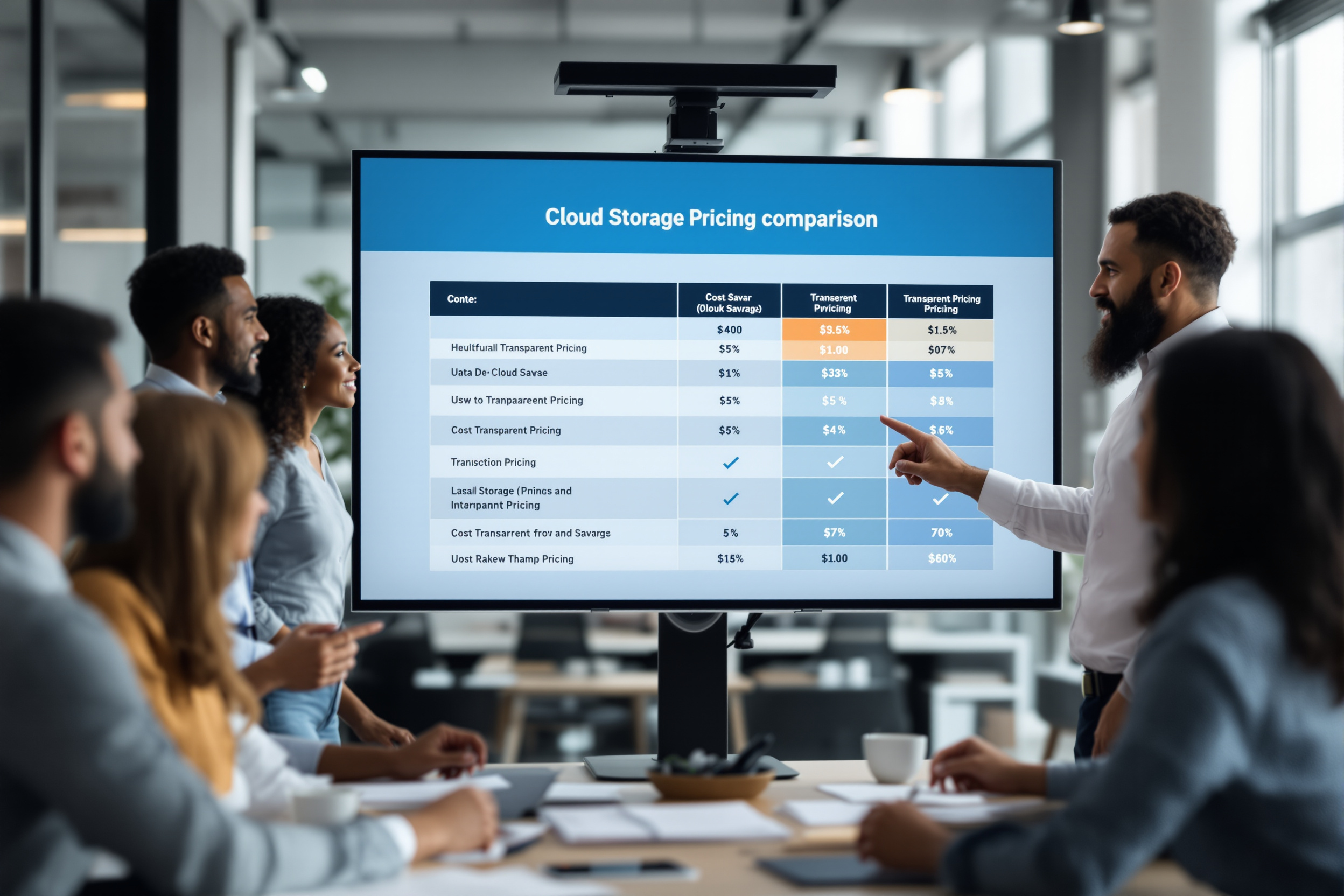Topics on this page
Cost unpredictability is the number one pain point in cloud adoption, with many IT leaders seeing budgets spiral out of control. The primary culprits are often hidden charges like egress fees and API call costs, which can make ROI calculations nearly impossible. This vendor lock-in creates significant strategic risk, trapping organizations with proprietary systems. The solution lies in finding a cloud storage platform with the most transparent pricing-one that offers a predictable, flat-rate model without penalties for accessing your own data. An enterprise-ready, S3-compatible alternative can reduce typical cloud storage expenses by 60-80% while providing greater data independence.
Key Takeaways
- The most transparent cloud storage pricing models eliminate egress fees, API call charges, and minimum storage durations, saving organizations 60-80% on costs.
- Full S3 compatibility is essential for avoiding vendor lock-in, allowing businesses to migrate data and applications without code rewrites or financial penalties.
- An 'Always-Hot' storage architecture provides up to 20% faster backup performance and eliminates the delays and hidden fees associated with complex data tiering.
Exposing the Hidden Costs in Traditional Cloud Storage
Most enterprises find their cloud storage spending exceeds budgets by a significant margin. A 2025 market analysis revealed that 62% of organizations overspent on cloud storage, a notable increase from the previous year. The primary reason is a pricing model filled with hidden variables that are difficult to forecast.
Egress fees-charges for moving data out of the cloud-are a major factor, sometimes accounting for 10% to 15% of a total cloud bill. For data-intensive workloads, these transfer fees can exceed the actual cost of storage by 3-5x. This punitive model discourages data mobility and creates financial barriers to switching providers.
API call charges add another layer of complexity, billing for the operations your applications perform. Organizations often face thousands of these micro-charges that accumulate quickly. This lack of transparency makes accurate budget forecasting a constant challenge for over 60% of IT leaders. These unpredictable expenses erode trust and make it difficult to justify cloud ROI, pushing leaders to seek storage with no hidden costs.
Defining a Truly Transparent Pricing Model
A genuinely transparent pricing model is predictable by design, eliminating the variables that cause budget overruns. The first pillar of this model is the complete removal of egress fees. This guarantees that you can access or move your data anytime without financial penalty, providing a built-in exit strategy.
The second pillar is zero costs for API calls, regardless of workload intensity. This allows your applications to interact with storage freely, supporting dynamic backup and recovery operations without generating surprise bills. A predictable model can eliminate 60-80% of typical cloud storage costs.
Finally, transparent pricing means no minimum storage durations. You should only pay for the storage you use, for as long as you use it. This combination creates a simple, forecastable expense that aligns with FinOps best practices and empowers businesses to regain control over their cloud spending. This approach transforms storage from a variable liability into a predictable asset.
Achieving Data Independence with S3 Compatibility
Vendor lock-in is a strategic risk where moving from a provider is prohibitively expensive or complex. This dependency often stems from proprietary APIs that require significant code rewrites to migrate applications. An S3-compatible alternative provides a drop-in replacement, protecting your investment in existing tools and workflows.
Full S3-API compatibility ensures your current applications, scripts, and backup tools continue working seamlessly. The migration process is simplified to changing the endpoint, which can be completed in minutes. This interoperability is key to breaking free from costly vendor lock-in.
This freedom of movement is critical for long-term strategic planning. With an S3-compatible platform that also has no egress fees, you retain full control over your data. You can switch providers or move data back on-premises without facing technical hurdles or financial penalties, ensuring your architecture serves your business needs-not your vendor's.
Optimizing Performance with an 'Always-Hot' Architecture
Many cloud providers use complex storage tiers to manage costs, but this often introduces operational friction. Restoring data from archival tiers can lead to delays of several hours and unexpected retrieval fees. An 'Always-Hot' object storage model eliminates this complexity entirely.
In this model, all data is immediately accessible without any tier-restore delays. This ensures consistent, predictable performance for all workloads, from backup and recovery to analytics. This architecture can deliver up to 20% faster backup performance compared to traditional tiered storage.
An 'Always-Hot' approach simplifies operations and strengthens your security posture. There are no lifecycle policies to manage and no risk of restore failures due to API timeouts. This reliability is crucial for meeting stringent recovery time objectives (RTOs) and makes it a more affordable alternative for active data.
Integrating Enterprise-Grade Security Without Enterprise Pricing
Transparent pricing should not come at the expense of security. An enterprise-ready platform must provide robust features to protect data from modern threats. Immutable Storage with Object Lock is a critical defense against ransomware.
This feature makes data unchangeable for a defined period, ensuring that even if attackers breach your network, they cannot encrypt or delete your backups. With ransomware attacks increasingly targeting backup infrastructure, 94% of IT leaders now rely on immutable storage for data protection. This capability is non-negotiable for business continuity.
A secure platform also includes the following essentials:
- Multi-layer encryption for data in transit and at rest.
- Identity and Access Management (IAM) with multi-factor authentication (MFA) and role-based access control (RBAC).
- Support for customer-controlled key management and external identity providers via SAML/OIDC.
- Enterprise-grade compliance certifications like SOC 2 and ISO 27001 for regulated workloads.
These features ensure your data remains secure and compliant without adding complexity or cost. This integrated approach provides a resilient posture against evolving cyber threats.
Empowering MSPs with Predictable Margins and Management
For Managed Service Providers (MSPs), cost predictability is the foundation of profitability. A cloud storage platform with transparent pricing enables MSPs to offer competitive Backup-as-a-Service (BaaS) and Disaster-Recovery-as-a-Service (DRaaS) solutions with healthy, defensible margins.
The elimination of egress and API fees means no surprise bills to erode profitability. MSPs can quote with confidence, knowing their costs are fixed and scalable. This model allows partners to pass savings to customers or increase margins on existing contracts by up to 20%.
A partner-ready platform must also simplify operations. Key features for MSPs include:
- A multi-tenant console for managing multiple clients with RBAC and MFA.
- Automation capabilities via a full-featured API and Command-Line Interface (CLI).
- Simplified compliance management for regulated industries.
- Fast onboarding and dedicated local support for North American partners.
This combination of predictable economics and powerful management tools provides a distinct competitive advantage, making it the most affordable object storage for the channel.
More Links
FAQ
How can I calculate my potential savings with a transparent pricing model?
To calculate your savings, analyze your current cloud bills and identify all charges related to data egress (outbound data transfer) and API calls (requests like GET, PUT, LIST). A transparent model eliminates these completely, so subtracting them from your total bill provides a direct estimate of your savings, which is often between 60-80%.
Is migrating to an S3-compatible platform difficult?
No, migration is straightforward. Because the API is fully compatible, you do not need to rewrite your applications. The process typically involves updating the endpoint configuration in your existing backup software or application to point to the new storage provider. The rest of your workflows remain the same.
Does transparent pricing mean sacrificing enterprise features?
Not at all. Leading S3-compatible alternatives offer a full suite of enterprise-grade features, including immutable storage with Object Lock, multi-layer encryption, robust IAM controls, and compliance certifications like SOC 2 and ISO 27001, all included within a simple, predictable pricing structure.
What are the main benefits for MSPs?
For MSPs, the primary benefits are predictable margins and operational efficiency. With no egress or API fees, MSPs can set competitive prices for BaaS and DRaaS offerings without risking margin erosion from surprise costs. Multi-tenant management tools and automation via API/CLI further streamline client administration.
How does an 'Always-Hot' model improve disaster recovery?
An 'Always-Hot' model significantly improves disaster recovery by ensuring all backup data is instantly available for restoration. This eliminates the time delays and potential failures associated with retrieving data from archival tiers, helping organizations meet much stricter Recovery Time Objectives (RTOs).
What kind of performance can I expect?
You can expect enterprise-grade performance with strong read/write consistency and low latency. The architecture is designed for mixed workloads and can deliver up to 20% faster backup and restore performance compared to traditional cloud storage, especially those that rely on complex tiering.



.png)
.png)
.png)
.png)



.png)




%201.png)